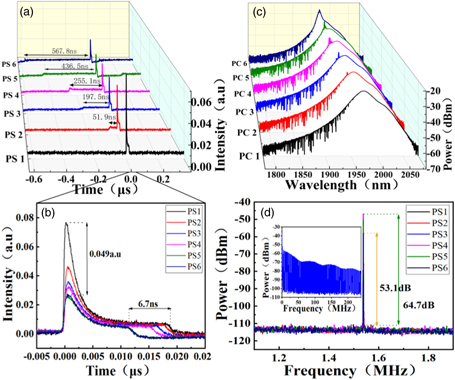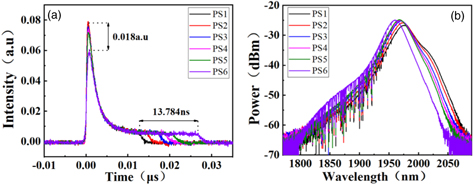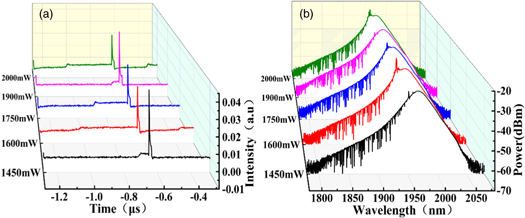Abstract
A novel h-shaped pulse train with a tunable leading-edge (resembling a h-shaped pulse merging with a weak square pulse) is experimentally generated in a Tm-doped mode-locked fiber laser (MLFL) incorporating a 100 m highly nonlinear fiber. Through carefully adjusting the pump power and cavity polarization states, the leading-edge duration of the obtained h-shaped pulse can be widely tuned from zero (corresponding to the typical conventional h-shaped pulse train) to 567.8 ns (equivalent to the cavity roundtrip time). Our results can further facilitate understanding the intrinsic mechanism and characteristics of novel h-shaped pulse dynamics in MLFLs.
Export citation and abstract BibTeX RIS
Owing to the numerous advantages including low threshold, high efficiency, and compactness, ultrafast mode-locked fiber lasers (MLFLs) have attracted considerable attention in various applications in the last few decades. Particularly, the ∼2 μm mid-infrared (mid-IR) Tm-doped MLFLs can have great prospects in fields like medicine,1,2) laser welding and material processing3) because they correspond to water molecules' ∼2 μm strong absorption band. Besides, they can also be used as pump sources to generate a mid-IR supercontinuum spanning longer wavelength (3–5 μm).4,5) Importantly, in scientific research, MLFLs have been considered as an excellent test bed to investigate nonlinear optics and soliton dynamics.6–10) As we know, the soliton pulse generation, propagation and evolution behaviors in MLFLs are governed by the extended Ginzburg–Landau equation, which takes into account the influence of the cavity dispersion, nonlinear effects, and the laser gain properties.11,12) Based on the guidance of the theoretical equation, many novel solitons have been discovered in experiments, such as dissipative solitons,13,14) dark solitons,15,16) vector solitons,17) soliton molecules,18,19) and so on. Besides, pulses and solitons with some special temporal profiles can also be generated in MLFLs employing different mode-locking techniques, such as step-like pulses,20) chair-like pulses,21) square-shaped dissipative soliton resonances (DSRs)22–26) and rectangular noise-like pulses.27,28) For specific applications like the field of laser materials processing, these high-energy pulses with tailored temporal profiles can be greatly useful. For example, a chair-like pulse, consisting of a long flattop portion in the leading part and a following high-peak-power short pulse, is demonstrated to be capable of improving laser-machining efficiency and quality, as the initial long pulse can contribute to the pre-heating of the materials and the subsequent short intense pulse induces the direct ablation of the materials. Recently, another type of h-shaped pulses was generated in a thulium-holmium-doped MLFL, which shows similar characteristics with the DSR pulses in terms of the peak-power-clamping29) induced wave-breaking-free property and the pump-power-dependent duration.30–32)
In this paper, we experimentally demonstrate the generation of another novel h-shaped pulse with a tunable leading portion from a Tm-doped MLFL at 1.973 μm based on the nonlinear polarization rotation (NPR) technology. A piece of 100 m highly nonlinear fiber (HNLF) is employed to increase the cavity nonlinearity and support the h-shaped mode-locked pulse generation. Under appropriate pump powers, stable leading-edge-tunable h-shaped pulses can be easily obtained by simply adjusting the cavity polarization state. Throughout the whole tuning process by manipulating the cavity polarization state and pump power, energy exchange occurs between the leading-edge portion and the peak and trailing-edge parts of the generated mode-locked pulses.
The schematic diagram of the Tm-doped MLFL is shown in Fig. 1. The ring laser cavity comprises a 5 m Tm-doped gain fiber (Nufern SM-TSF-9/125) which was backward-pumped by a 2 W fiber laser source at 1570 nm via a 1570/2000 nm WDM, a piece of 100 m HNLF (OFS HNLF ZDW-1546), two sets of in-line polarization controllers (PCs), a polarization-dependent isolator (PD-ISO), and a fused 10% output coupler (OC), resulting in a total cavity length of 132.7 m. The PD-ISO and the two PCs are responsible for the self-started stable mode-locking of the fiber laser based on the widely used NPR technique. The 10% output port of the OC was monitored by an optical spectrum analyzer (Yokogawa, AQ6375B, Japan) and a 12.5 GHz high-speed oscilloscope (Tekrtonix, DPO71254C, USA) together with a 12.5 GHz photoelectric detector (E-O Tech. Inc., ET-5000F) simultaneously to record the output spectrum and the pulse train, respectively. A radio frequency (RF)-spectrum analyzer (Keysight, N9322C, USA) was used to measure the RF spectrum.
Fig. 1. (Color online) Experimental schematic of the mode-locked fiber laser for the leading-edge-tunable h-shaped pulse generation. WDM: wavelength division multiplexer; TDF: thulium-doped fiber; HNLF: highly nonlinear fiber; PC: polarization controller; PD-ISO: polarization-dependent isolator; OC: output coupler; OSC: oscilloscope; OSA: optical spectrum analyzer: PD: photo-detector.
Download figure:
Standard image High-resolution imageWhen the pump power was set to a relatively low level of 0.85 W, typical h-shaped mode-locked pulses can be obtained from the Tm-doped fiber laser. It is worth noting that in this situation the leading edge of the h-shaped pulses is steep and fixed while adjusting the cavity conditions in terms of changing the pump power or varying the cavity polarization states through changing the orientations of the PCs' paddles. The typical conventional h-shaped mode-locking pulses were shown in Figs. 2(a) and 2(b). When we further increased the pump power to a moderate level of 1.75 W and carefully optimized the cavity polarization states, another brand-new h-shaped mode-locked pulse train with a tunable square leading-edge was observed, as shown in Figs. 2(c) and 2(d), corresponding to pulse trains with different time scales. When we finely adjusted the PCs, the leading-edge duration of the pulses could be continuously tuned. Figure 3 shows the temporal evolution process of the pulses when varying the polarization states at the same pump power of 1.75 W. We can see that the leading-edge duration can be tuned from zero to 567.8 ns, as shown in Fig. 3(a). Figure 3(b) is a close-up of Fig. 3(a) displaying the details concerning the pulse peak and the trailing-edge. It is worth noting that the cavity polarization state of PS1 corresponds to the conventional h-shaped pulse generation with zero leading-edge duration. When the polarization state switches to PS2 by finely adjusting the PCs, an obvious square leading-edge appears across the whole pulse while its trailing-edge is shortened correspondingly along with reduced peak intensity. This means that a portion of the energy in the peak and trailing-edge part has been transferred to the leading-edge part. The output spectrum of the mode-locked h-shaped pulse train with a square leading-edge exhibits small peaks riding on a broad and smooth pedestal, as shown in Fig. 3(c). The intensity of the small peaks grows increasingly when the leading-edge enlarges. We can conclude that the frequency components corresponding to the small peaks on the spectrum result in the generation of the square leading-edge. Figure 3(d) shows the RF spectra for the output h-shaped pulse train with square leading-edges under different polarization states, from which we can see that the fundamental frequency stays almost the same at around 1.54 MHz for all situations, and the signal-to-noise ratios (SNRs) remain a high level with a maximum value of 64.7 dB. Although the SNRs show a fluctuation among different polarization states, they all exceed 53 dB, representing a high temporal stability.
Fig. 2. (Color online) Pulse trains of the conventional h-shaped pulses: (a) and (b), and the leading-edge tunable h-shaped pulses: (c) and (d), corresponding to different time scales.
Download figure:
Standard image High-resolution imageFig. 3. (Color online) Output characteristics of the leading-edge tunable h-shaped pulses: (a) temporal profiles and (b) a close-up cross-section of (a); (c) the corresponding output spectra under different polarization states; (d) the RF spectra of the output pulses under different polarization states.
Download figure:
Standard image High-resolution imageIt should be noted that, under the regime of conventional h-shaped pulses with zero leading-edge duration, when we were trying to further reducing the leading-edge duration by finely varying the orientations of the PCs, the steep leading-edge remained unchangeable while the trailing-edge became broadened with a reduced peak intensity instead. Figure 4 shows the temporal evolution of the conventional h-shaped mode-locked pulses with zero leading-edge duration under different polarization states at the same pump power of 1.75 W. Through carefully varying the orientations of the PCs' paddles, the trailing-edge of the pulses can be tuned over a temporal span of around 13.78 ns with a constant intensity, as shown in Fig. 4(a). Broader tuning range can be achieved by increasing the linear cavity birefringence, such as incorporating polarization maintaining fiber with an appropriate length, as illustrated in Ref. 24. The corresponding evolution of the output spectrum is also shown in Fig. 4(b), from which we can see that the center wavelength shifts to the shorter wavelength side gradually from ∼1976 to ∼1959 nm as the trailing-edge duration increases. This can be attributed to the cavity-spectral-filtering effect determined by the net phase delay. The shorter wavelength of the spectrum can experience lower loss when adjusting the cavity birefringence induced by the PCs in this situation.
Fig. 4. (Color online) Temporal evolution of the conventional h-shaped pulses at the pump power of 1.75 W: (a) single pulse envelopes and (b) corresponding spectra under different polarization states (PSs).
Download figure:
Standard image High-resolution imageFigure 5 summarizes the specifications of the leading-edge tunable h-shaped pulses in terms of the peak intensity [Fig. 5(a)], leading-edge duration [Fig. 5(b)] and trailing-edge duration [Fig. 5(c)] under different polarization states. The leading edge was broadened gradually when the PCs were tuning from PS1 to PS6, spanning from zero to ∼567.8 ns which is equivalent to the entire pulse period time. Concerning the peak intensity and trailing-edge duration, they behave contrarily, which represents the energy transfer between these two portions. The trailing-edge duration varied from 12.02 to 5.28 ns as the polarization states were tuned from PS1 to PS6, as shown in Fig. 5(c). It is worth noting that the average output power remains approximately the same at around 20 mW throughout the whole tuning process.
Fig. 5. (Color online) Evolution process of (a) the peak intensity, (b) the leading-edge duration and (c) the trailing-edge duration with different polarization states at the pump power of 1.75 W.
Download figure:
Standard image High-resolution imageAdditionally, we can also observe this type of leading-edge tunable h-shaped pulses at other pump powers like 1.15, 1.45, and 2 W, and they all exhibit similar lasing characteristics. It is worth noting that the leading-edges of such type of h-shaped pulses can always be tuned from none to occupying the whole roundtrip time, while the trailing-edges possess different tuning ranges at different pump powers. Moreover, at low pump power levels, both the leading-and trailing-edges would drift slightly even with a fixed polarization state, while exhibiting high stability at high pump power levels. When the pump power is lower than 1.15 W, it is difficult to achieve the leading-edge tunable h-shaped pulses while the typical conventional h-shaped pulses can exist in the laser cavity. This is because the spectral components (typical pinnacles riding on the output spectrum) corresponding to the square leading-edge can only be formed at high pump power levels.
To find the intrinsic mechanism behind the leading-edge tunable h-shaped pulse generation, we also investigated the relationship between the pulse characteristics and the pump power. Figure 6(a) shows the evolution of temporal profiles under different pump powers of 1.45 W, 1.60 W, 1.75 W, 1.9 W, and 2.0 W, respectively, with fixed orientations of PCs. As can be seen, in such a broad pump power tuning range, we cannot capture any universal principle regarding the relationship between the pump power and the pulse specifications including the peak intensity, the trailing-edge duration, and the leading-edge duration. These parameters are not varying monotonously within the broad pump power tuning range. We can conclude that this type of leading-edge tunable h-shaped pulses is very sensitive to the cavity birefringence variation and phase delay induced by the significant pump power change owing to the relatively low intensity of the square leading-edge. When the pump power increases over a certain threshold the original pulse train will become unstable. At this time, the wave-breaking and self-organization behaviors occur, and a stable new pulse train at the same fundamental frequency can be formed. This is quite different from the conventional typical h-shaped pulses generated from MLFLs, whose trailing-edge would be significantly broadened as the pump power increases. The corresponding output spectra are also shown in Fig. 6(b). The intensity of the small peaks on the spectrum corresponds to the energy of the leading-edge portion.
Fig. 6. (Color online) Output characteristics of leading-edge tunable h-shaped pulses: (a) pulse envelopes and (b) the corresponding output spectra under different pump powers.
Download figure:
Standard image High-resolution imageTo confirm whether the leading-edge tunable h-shaped profile packet has the same internal fine structures as the noise-like square-wave pulses, we also performed the auto-correlation measurement using the available autocorrelator in our lab (APE, PulseCheck USB 150). No obvious auto-correlation pulse signals were detected. This means that the long leading-and trailing-edges are not comprising of bunch of short pulses with stochastic peak power and pulse durations from several tens of femtoseconds to one hundred picoseconds. Presumably, the output pulses can be considered as a single packet and maintain very good pulse-to-pulse coherence.
In this experiment, flexible tuning in terms of the peak intensity, pulse durations of the leading- and trailing-edges for the special h-shaped pulses can be realized through manipulating the pump power and polarization states. Much richer pulse dynamics can be obtained by further increasing the pump power, such as the harmonic mode-locking operation, as reported in Ref. 26. Besides, in contrast to the obtained conventional mode-locked pulses with certain temporal profiles (e.g. step-like pulse,15) chair-like pulse,16) DSR17–21) and traditional h-shaped pulse24)), we would like to assume that the leading-edge tunable pulses are comprising of two portions, the square-shaped leading edge and the conventional h-shaped pulse. The former part corresponds to the spectral components locating on top of the output spectrum while the latter one is determined by the broad and smooth pedestal. We attributed the formation of the square leading- and trailing-edges of the h-shaped pulses to the peak-power-clamping effect. When we adjusted the pump power or varied the polarization states, the energy transfer between these two portions occurred. This is because the leading- and trailing-edges with relatively low intensities are more sensitive to the variation of cavity conditions. Further experimental and theoretical work are required to investigate this new type of pulses while our work can provide a good start for the contribution to understand the underlying mechanism.
In conclusion, we demonstrated here the generation of another new type of leading-edge tunable h-shaped pulses from a ∼2 μm Tm-doped MLFL incorporating a piece of HNLF. Pulse evolution characteristics in relation to the pump power and the cavity polarization state are carefully investigated. By manipulating the pump power and the cavity polarization states, the leading-edge duration can be widely tuned from zero (corresponding to the typical conventional h-shaped pulse train) to 567.8 ns (almost occupying the pulse roundtrip time). Further work is required to clarify the intrinsic mechanism of this novel type of mode-locked pulses. Our results indicate that the passively MLFLs with a large nonlinearity have been an excellent platform to investigate the rich behaviors of nonlinear soliton dynamics.
Acknowledgments
This work was supported in parts by the National Natural Science Fund Foundation of China (NSFC) (Grants 61805115, 61875132, and 61606166), and Shenzhen Government's Plan of Science and Technology (Grant No. JCYJ20170302153731930).








